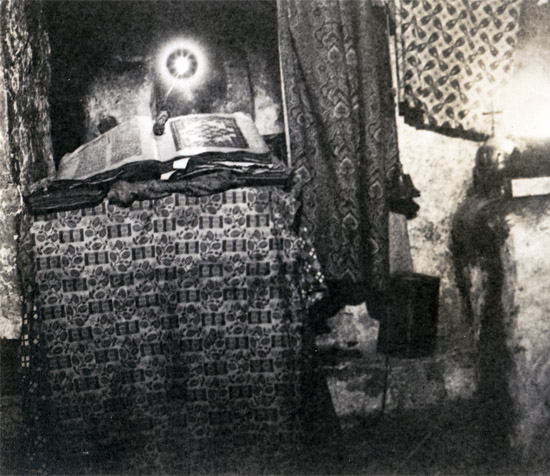Photograph of burned Shepheard Hotel in Cairo, by the Armenian photographer KEROP. The Cairo riots on January 26, 1952, targeted establishments owned, or frequented, by the British British in Egypt, burned the world most famous Hotel, thus signaling the end to an era stretching back to 1842, when the early Shepheard was established to accommodate the increasing number of travelers using the Over Land route to India, from Alexandria to Suez by the way of Cairo, and from Suez to India by the Red Sea, prior to the opening of the Suez Canal. The Egyptian Revolution of July, 23, 1952 put an end to the Royal House of Muhammad Ale Pasha, and exiled King Farouk

Category Archives: Art Objects/Architecture
The Atrash clan house in Jabel al Druze, The Roman columns and the new house, are composed from the Basalt rocks that prevail in the volcanic mountain of the Druze. To the Druze who settled the poorly inhabited region belongs the credit for preserving the Roman and Byzantine remains, a feature unique to Syria in preserving history.

Sheikh Khaz’al ibn Jabir palace and music band on post card mailed 23 Jan. 1909 from Bader Abbas.The Sheikh belonged to the Beni Ka’ab Arab tribe in the Ahwaz region along the Persian Gulf, friend of the British prior to WW1, was placed under house arrest in Tehran in 1925, when the Pahlevi dynasty forces occupied the region. the Ahwaz name was Persinized to Khuzistan, and in 1930 Sheikh Khaza’al’s Capital Mohammerah was changed to Khurramshahr. Sheikh Khaza’al at some point was considered strong candidate for the throne of Iraq was passed over, by King Faisal I. He died in Tehran while under house arrest, betrayed by his old friends, the British.

Jonas tomb in Ninevah across the Tigris from Mosul in northern Iraq 1922. The prophet Jonah, Jonas, Younes in Arabic, Younan in Assyrian, was 8th century B.C. prophet sent by God to warn the population of Ninevah about their ways. buried on one of the two mounds of old Ninevah, the Naby younes mound, the other mound being Kouynjuk, mound, extensively dug by archeologist Austen Layrd and Rassam in the 1840’s. A very important pilgrimmage site for Jews, Christians, and Muslims

Diyarbekir [Kara Amed] the capital of upper Mesopotamia, on the Tigris in South Eastern Turkey, home to Armenians,Chaldeans, Assyrians, Syrian Orthodox [Monophysites], Yezidis, Qizil Bash, and Kurds. Minarets and church bell towers seen in the background, prior to WW1. In the fore- ground, and on the roofs of the historical city, the dwellers slept in the heat of Mesopotamia

Nusaybin (also Nisibis). An ancient town fought over by the Persian and Roman empires. Major center for the monophysite Syrian church movement of the 5th and 6th centuries. Photo taken by German military assigned to the British POW of Kut in Mesopotamia in 1916 during their march to Anatolia . The shop keepers (Kurdish Jews) and their covered wives in white covers, migrated in mass to the Syrian town across the new border between Syria and Turkey post WW1 and formed the bulk of the Kurdish speaking Jewish community of Qamishli, considered the 3rd largest community of Syrian Jews after Aleppo and Damascus. The Berlin -Baghdad Railway ended at Nusaybin at break of WW1. Click here to read more.























